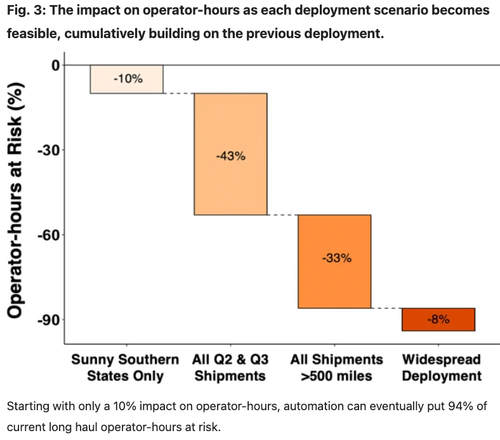Automated Trucks Could Displace Half Million US Jobs
Automation is flooding into the trucking industry as a nationwide shortage of drivers persists. Self-driving trucks are already on America’s highways, currently in the testing phase, as a new study warns up to a half-million jobs are at risk of being displaced by robots.
Researchers at the University of Michigan and Carnegie Mellon University published a new study, revealing the proliferation of automation in long-haul trucking could replace 94% of human truck drivers, the equivalent of approximately 500,000 jobs.
“Our results suggest that the impacts of automation may not happen all at once,” said study co-author Parth Vaishnav, assistant professor of sustainable systems at the University of Michigan.
“If automation is restricted to Sun Belt states (including Florida, Texas and Arizona)—because the technology may not initially work well in rough weather—about 10% of the operator hours will be affected,” Vaishnav said.
Researchers developed several automated trucking deployment scenarios, including deployment in southern states, deployment for journeys more than 500 miles, and widespread deployment across the country.
“Our study is the first to combine a geospatial analysis based on shipment data with an explicit consideration of the specific capabilities of automation and how those might evolve over time,” said lead author Aniruddh Mohan, a doctoral candidate in engineering and public policy at Carnegie Mellon.
Depending on the scenario, they found the rollout of automation may have a 10% to 94% impact on long-haul operator-hours, equivalent to 30,000 to 500,000 jobs that could be displaced.
Researchers also interviewed trucking companies, logistical experts, and tractor-trailer operators to develop a roadmap of the automation rollout within the trucking industry.
“A key finding was just how economically attractive this technology would be and the fact that everyone, including truckers, agreed that the interstate part of the job could be automated,” Vaishnav said.
“Ultimately, societal and political choices can determine the mode of deployment of automated tracking capabilities, as well as the winners and losers of any shift to automation of long-haul trucking,” he said.
One of the most significant hurdles for automated trucks is infrastructure. Researchers created a schematic showing the future of trucking driving. The automation part will mainly be on highways.
The rollout of automated trucks could be a few years away as San Diego-based TuSimple tested the first class 8 vehicle (otherwise known as a trailer tractor) on a highway without human intervention. The test was conducted on Dec. 22 on an 80 mile stretch of road between Tucson, Arizona, and Phoenix.
Trucks move 70% of U.S. freight in weight, and labor and fuel costs pressure logistics companies’ margins, forcing them to raise shipping rates or face margin compression.
Today’s high inflationary environment (some say stagflation is imminent) could push more and more companies into eventually firing human truck drivers for robot ones to cut down on costs.
Tyler Durden
Wed, 03/23/2022 – 23:20

